
Moritz Kuhn
@mokuhn.bsky.social
Professor of Economics, U Mannheim, private account=private opinion
We provide a new answer to an old question in labor market research establishing separation rates as an important margin of adjustment after UI reforms. We also highlight the importance of the wage-job-stability trade off as adjustment mechanism! 10/10
👉 academic.oup.com/restud/artic...
👉 academic.oup.com/restud/artic...
March 27, 2025 at 7:24 AM
We provide a new answer to an old question in labor market research establishing separation rates as an important margin of adjustment after UI reforms. We also highlight the importance of the wage-job-stability trade off as adjustment mechanism! 10/10
👉 academic.oup.com/restud/artic...
👉 academic.oup.com/restud/artic...
We show that we should expect such a strong reaction of separation rates after UI reforms in countries with low job-finding rates as in 🇩🇪 & most 🇪🇺 countries, while the main adjustment will come from job-finding rates in countries like the 🇺🇸 with high job-finding rates. 9/10
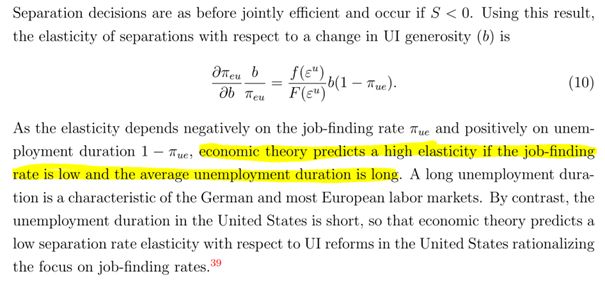
March 27, 2025 at 7:24 AM
We show that we should expect such a strong reaction of separation rates after UI reforms in countries with low job-finding rates as in 🇩🇪 & most 🇪🇺 countries, while the main adjustment will come from job-finding rates in countries like the 🇺🇸 with high job-finding rates. 9/10
Without the UI reform, German unemployment rates would have been 50% higher a decade later. This model-based estimate is confirmed by an empirical estimate (synthetic control estimate). 8/10
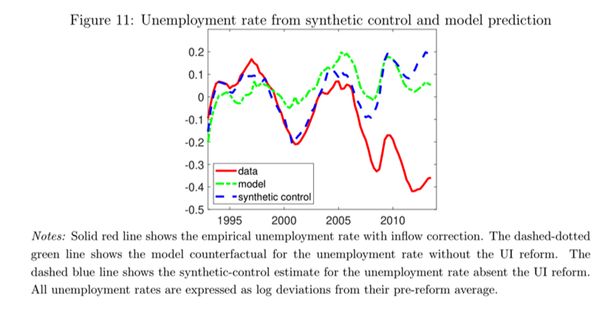
March 27, 2025 at 7:24 AM
Without the UI reform, German unemployment rates would have been 50% higher a decade later. This model-based estimate is confirmed by an empirical estimate (synthetic control estimate). 8/10
In the second part of the paper, we generalize our empirical findings based on economic theory. We develop a model with a frictional labor market and demonstrate that the predictions from theory match closely the empirical facts on average and with respect to heterogeneity. 7/10

March 27, 2025 at 7:24 AM
In the second part of the paper, we generalize our empirical findings based on economic theory. We develop a model with a frictional labor market and demonstrate that the predictions from theory match closely the empirical facts on average and with respect to heterogeneity. 7/10
The mechanism is a trade-off between wages and job stability: long-term employed workers accepted wage declines for additional job stability to prevent unemployment. This wage-job-stability trade-off is known in theory but we demonstrate its empirical importance! 6/10
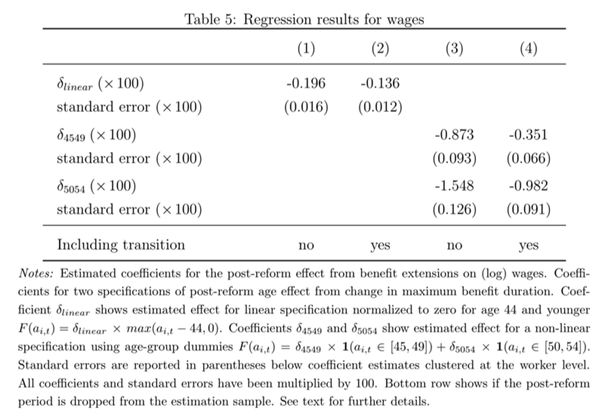
March 27, 2025 at 7:24 AM
The mechanism is a trade-off between wages and job stability: long-term employed workers accepted wage declines for additional job stability to prevent unemployment. This wage-job-stability trade-off is known in theory but we demonstrate its empirical importance! 6/10
We provide causal evidence of the decline in UI generosity on the separation rate decline by exploiting that different worker groups have been differently affected by the reform (old and young workers, short- and long-term employed workers). 5/10
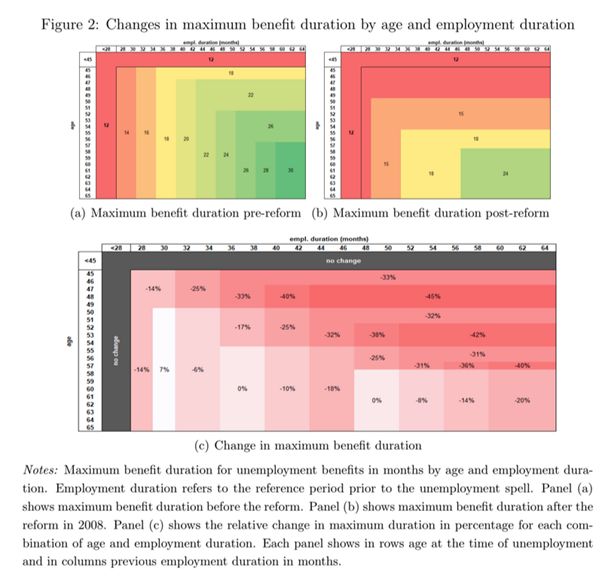
March 27, 2025 at 7:24 AM
We provide causal evidence of the decline in UI generosity on the separation rate decline by exploiting that different worker groups have been differently affected by the reform (old and young workers, short- and long-term employed workers). 5/10
The decline is strongest for workers who we typically think of as the least affected by UI reforms: older and long-term employed workers. These workers constitute most of the employment in the German labor market. 4/10

March 27, 2025 at 7:24 AM
The decline is strongest for workers who we typically think of as the least affected by UI reforms: older and long-term employed workers. These workers constitute most of the employment in the German labor market. 4/10
Decomposing the decline in the unemployment rate in the decade after the reform, we find that 76% of the decline came from lower separation rates only about one-third of the decline came from higher job-finding rates. 3/10

March 27, 2025 at 7:24 AM
Decomposing the decline in the unemployment rate in the decade after the reform, we find that 76% of the decline came from lower separation rates only about one-third of the decline came from higher job-finding rates. 3/10
We study this question based on the German Hartz reforms, one of the largest UI reforms in recent decades. After the reform unemployment has been in half. How? The key was not more jobs found (higher job-finding rates) but fewer jobs lost (lower separation rates). 2/10
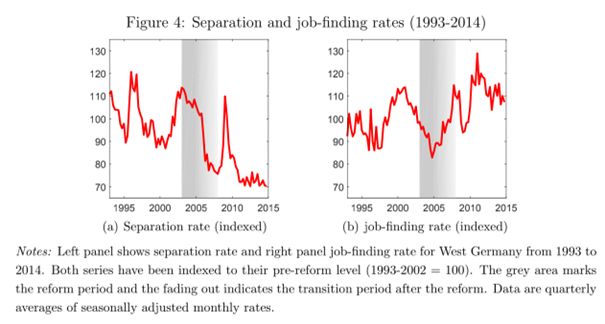
March 27, 2025 at 7:24 AM
We study this question based on the German Hartz reforms, one of the largest UI reforms in recent decades. After the reform unemployment has been in half. How? The key was not more jobs found (higher job-finding rates) but fewer jobs lost (lower separation rates). 2/10
Reposted by Moritz Kuhn
Thanks to all the participants for joining the discussion!
@michaeldbauer.bsky.social @christian-bayer.bsky.social @bernothkerstin.bsky.social Peter Bofinger @bborn.bsky.social @grimmveronika.bsky.social Hans Peter Grüner Martin Hellwig Philipp Jung 2/3
@michaeldbauer.bsky.social @christian-bayer.bsky.social @bernothkerstin.bsky.social Peter Bofinger @bborn.bsky.social @grimmveronika.bsky.social Hans Peter Grüner Martin Hellwig Philipp Jung 2/3
March 17, 2025 at 9:55 PM
Thanks to all the participants for joining the discussion!
@michaeldbauer.bsky.social @christian-bayer.bsky.social @bernothkerstin.bsky.social Peter Bofinger @bborn.bsky.social @grimmveronika.bsky.social Hans Peter Grüner Martin Hellwig Philipp Jung 2/3
@michaeldbauer.bsky.social @christian-bayer.bsky.social @bernothkerstin.bsky.social Peter Bofinger @bborn.bsky.social @grimmveronika.bsky.social Hans Peter Grüner Martin Hellwig Philipp Jung 2/3
Reposted by Moritz Kuhn
@mokuhn.bsky.social Emanuel Mönch Ulrike Neyer @monika-schnitzer.com @schoefer.bsky.social @peterhtillmann.bsky.social @ulbrich-jens.bsky.social @wederdim.bsky.social 3/3
March 17, 2025 at 9:55 PM
@mokuhn.bsky.social Emanuel Mönch Ulrike Neyer @monika-schnitzer.com @schoefer.bsky.social @peterhtillmann.bsky.social @ulbrich-jens.bsky.social @wederdim.bsky.social 3/3
Congratulations @cmatthes.bsky.social
February 15, 2025 at 2:28 PM
Congratulations @cmatthes.bsky.social

